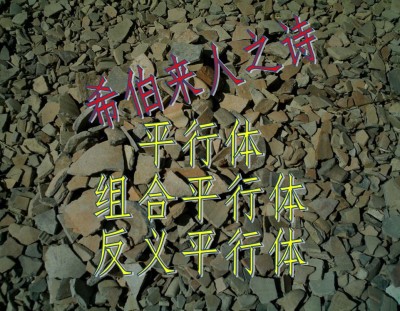 撒母耳记下22章:大卫颂赞神之诗歌
撒母耳记下22章:大卫颂赞神之诗歌
1. 撒母耳记下22章和诗篇18篇几乎是一样的。有些圣经学者认为此诗是大卫被立为王之后,但是和拔示巴犯罪之前写的。
2. 可把这首诗歌分为三大部分,加上引言和结论。请用自己的话来形容五部分的内容:
① 2-4节:引言:
② 5-20节:
③ 21-30节:
④ 31-46节:
⑤ 47-51节:结论:
3. 虽然大卫王的诗歌很古老,但这诗歌是典型希伯来人写的诗。以下的是希伯来人写诗之写法的简介。(注意:如果您已读过本作者写的其他的旧约圣经教材,也许您已经看过这种资料。再次重复此资料积极地强调我认为这是何等重要。)
1) 希伯来人的诗相当于中国人的对联;圣经的学者把它称为“平行体”(Hebrew Parallelism)。恐怕大卫王不知道“平行体”这个词,但是解《经》家Robert Lowth于1753年用“平行体”这个词描述希伯来人写诗的写法。如果我们理解“平行体”是什么,它会帮助我们懂得《圣经》内容, 特别是用“诗”来写的那部分圣经旧约。诗篇,箴言,传道书等。以赛亚书,耶利米书,小先知书都是“诗”或有部分是用“诗”写的。
2) “平行体” (Hebrew Parallelism) 分为三种也就是三个主要的写法,如下:
一)“同义平行体” (Synonymous Parallelism):最普遍的平行体。前导和后导是同一个意思。后导重复前导。
二)“组合平行体”(Progressive or Synthetic Parallelism):前导不完全,不完整,不单独存在;它需要后导补充。
三)“反义平行体”(Contrasting or Antithetic Parallelism):前导和后导是相对的意思。
4. 请自选撒母耳记下22章里的任何五节,按照以上所说的“平行体”的简介来解释。

图片:考古学家发现许多陶瓷碎片。好的,有时候他能够用胶水把一些组合起来还原为原来的瓦器,如油灯、水瓶、酒瓶等。但,大部分的碎片他就扔掉。此照片就是考古学家所扔掉的陶瓷碎片。地点是以色列的伯示麦。Photo ©Edward Short.
读者:欢迎您把这篇短文下载,复印,用在您的《圣经》班里。
2 Samuel 22: David’s Song of Praise
1. 2 Samuel 22 and Psalm 18 are practically the same. Some Bible scholars believe that David wrote this poem after he became king, but before he sinned with Bathsheba.
2. This poem can be divided into three major parts plus an introduction and a conclusion. Using your own words, describe the content of all five parts: Vs. 2-4 (introduction); vs. 5-20; vs. 21-30; vs. 31-46; vs. 47-51 (conclusion).
3. Although the poem by King David is very ancient, it is an example of typical Hebrew poetry. Below is an introduction to Hebrew poetry. (Note: If you have studied other books in this series of Old Testament lessons, perhaps you have had already been exposed to some of this material. The fact that I repeat it in this lesson indicates how important I believe this information is to properly understanding the Old Testament.)
1) The way Hebrew people wrote poetry is very similar to the way Chinese write “couplets” (such as are written on door frames at Lunar New Year). Bible scholars call this form “Hebrew Parallelism.” King David probably did not know the term “Hebrew Parallelism,” but Bible scholar Robert Lowth, in 1753, used it to describe the way Hebrews wrote poetry. Understanding “parallelism” helps us understand those parts of the Bible that are poetry, e.g., Psalms, Proverbs, Ecclesiastes, etc. Isaiah, Jeremiah and the Minor Prophets are written in poetic form or include poetry.
2) There are three basic types of Hebrew Parallelism:
1- Synonymous Parallelism: This is the most common form of Hebrew Parallelism. The first clause or line and the second mean the same thing; the second line repeats the first line.
2- Progressive or Synthetic Parallelism: The first line is incomplete and does not stand alone; the first line supplements the second line.
3- Contrasting or Antithetic Parallelism: The second clause (line or thought) gives an opposite meaning of the first line.
4. Pick any five verses from 2 Samuel 22 and explain them according to the introduction to “Hebrew parallelism” above.
Photo: Potsherds uncovered by archaeologists. Sometimes an archaeologist can glue pieces of potsherd together and remake the original item–an oil lamp or a water jar or a wine jar. Most of the potsherds, however, are thrown away. The photo above is a pile of discarded potsherds at Tel Beth Shemesh, Israel. Photo ©Edward Short.
圣经问答
撒母耳记下22章:大卫颂赞神之诗歌
Bible Study Questions: 2 Samuel Lesson Sixteen
2 Samuel 22: David’s Song of Praise
作者:谢德华 ©By Edward Short
本文所问的问题使用汉子圣经。
欢迎您把此文件下载用在圣经班或私人学习。
A series of Bible lessons, written in Chinese
and based largely on the text of the Chinese Bible.
You may download and print copies of this lesson
for use in your Bible class.
